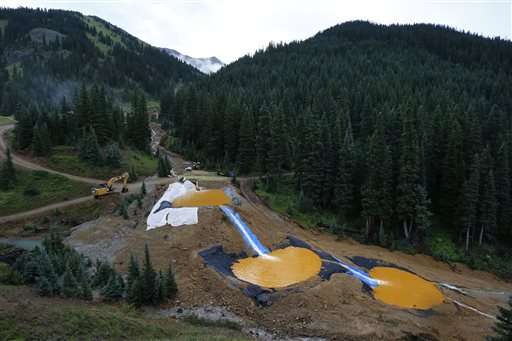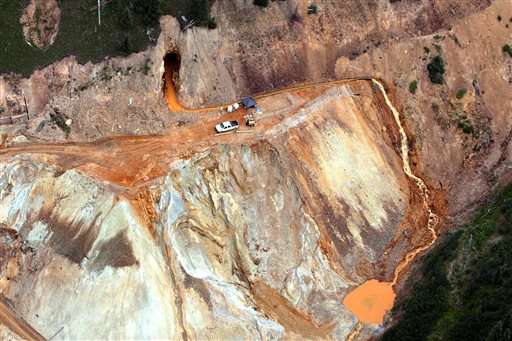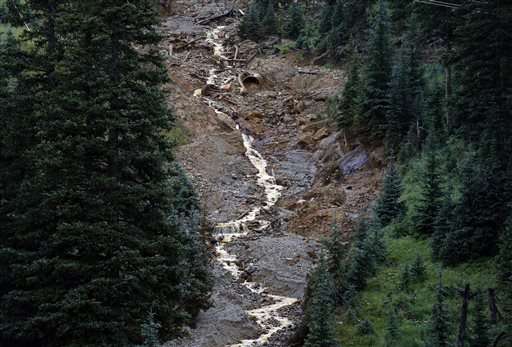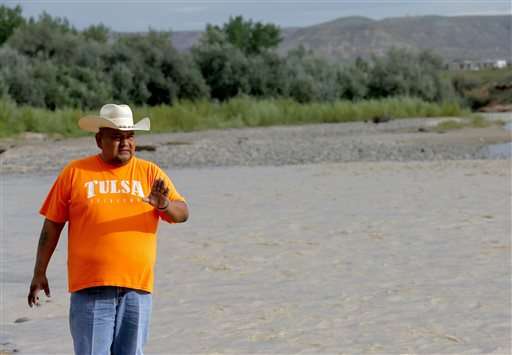Water flows through a series of retention ponds built to contain and filter out heavy metals and chemicals from the Gold King mine wastewater accident, in the spillway about 1/4 mile downstream from the mine, outside Silverton, Colo., Wednesday, Aug. 12, 2015. The EPA has taken full responsibility for the mine waste spoiling rivers downstream from Silverton, but people who live near the idled and leaking Gold King mine say local authorities and mining companies spent decades spurning federal cleanup help. (AP Photo/Brennan Linsley)
Toxic waste that gushed from a Colorado mine and threatened downstream water supplies in at least three states will continue to be dangerous when contaminated sediment gets stirred up from the river bottom, authorities said Wednesday, suggesting there is no easy fix to what could be a long-term public health risk.
The immediate impact of the 3 million gallon spill on Aug. 5 eased as the plume of contamination dissipated on its way to Lake Powell along the Utah-Arizona border. But the strong dose of arsenic, cadmium, lead and other heavy metals settled out as the wastewater traveled downstream, layering river bottoms with contaminants sure to pose risks in the future.
"There will be a source of these contaminants in the rivers for a long time," said hydrologist Tom Myers, who runs a Nevada-based consulting business. "Every time there's a high flow, it will stir it up and it will be moving those contaminants downstream."
The U.S. Environmental Protection Agency had pushed for 25 years to grant Superfund status to the partly collapsed Gold King mine and other idled mines leaking heavy metals above the old mining town of Silverton, Colorado. That would have brought in major funds for a comprehensive cleanup.
Local authorities spurned federal intervention, leaving a smaller EPA-led team to investigate a small if steady stream of pollution. That team accidentally breached a debris wall at the mine, unleashing the pool of contaminated water that turned the Animas River yellow.
EPA Administrator Gina McCarthy, on a visit Wednesday to Durango, downstream of the spill site, said she had ordered agency personnel across the country to cease field investigation work on abandoned mines while the spill was investigated. EPA officials said they were seeking details on what the stop-work order means.
State attorneys general from Colorado, New Mexico and Utah appeared separately in Durango, pledging to make sure residents are compensated for damages from the spill. But they said they would hold off on legal action against the federal government to give the EPA a chance to prove it will be accountable.
Also Wednesday, Colorado state health officials informed residents in Durango that they can resume using treatment facilities that draw water from the Animas.
Long before the accident, mines in the Silverton area that were first developed in the late 1800s had been releasing steady streams of contaminated wastewater into area creeks, leaving some of them virtually lifeless. No fish swim where the runoff from the Gold King mine flows into Cement Creek and the upper reaches of the Animas, which in turn feeds the San Juan River.
One week after the spill, the EPA said runoff had returned to its normal levels of about 213 gallons per minute. Agency cleanup crews hastily built a series of four sedimentation ponds, bulldozing mounds of earth and covering pits in plastic, to clean the runoff from the mine before it drains into the creek.
In this aerial photo taken Tuesday, Aug. 11, 2015, waste water continues to stream out of the Gold King Mine near Silverton, Colo. Frustration is mounting throughout the Four Corners region among officials and residents who say the EPA has moved too slowly and hasn't been forthcoming about the dangers of the spill. (Geoff Liesik/The Deseret News via AP)
The agency said Wednesday that the ponds were reducing acidity and dissolved metals and that the runoff is now cleaner than it was before the spill. The ponds brimmed with yellow-tinted runoff outside the old mine, located 11,300 feet high in the Rocky Mountains.
EPA spill liaison Nat Miullo suggested the danger from the spill had diminished with the dissipation of the initial burst of tainted water. Any future spike in contaminant levels caused by stirring up sediments would be "much, much smaller in scale," he said.
But environmental regulators in downstream New Mexico warned that it was crucial to determine where the contamination settles.
"Those are some of the longer-term issues that affect humans as well as wildlife," New Mexico Environment Secretary Ryan Flynn said.
While there have been no fish or bird die-offs, Flynn said that doesn't mean the river is healthy or safe. He said more testing is needed.
Past mine waste accidents in the Rocky Mountains show the impact can linger for decades, said John Stednick, a watershed scientist at Colorado State University.
He cited efforts to clean up Colorado's stretch of the Arkansas River that began with a 1982 spill, and the fish kills that came after Summitville Mine dumped wastewater into Wightman Fork, near Del Norte, Colorado.
"It takes years for sediments to clean once acid mine drainage has been removed," Stednick said.
Water flows down from the Gold King mine, where several days earlier an accident led to the release of heavy metals and chemical-laden wastewater, outside Silverton, Colo., Wednesday, Aug. 12, 2015. The Environmental Protection Agency has taken full responsibility for the mine waste spoiling rivers downstream from Silverton, but people who live near the idled and leaking Gold King mine say local authorities and mining companies spent decades spurning federal cleanup help. (AP Photo/Brennan Linsley)
The Gold King spill was proving devastating to the Navajo Nation, which recently negotiated a settlement giving it rights to water from the San Juan River. The tribe plans to build a $20 million water treatment plant in northwestern New Mexico to take in the extra volume of water granted by the settlement and provide a clean drinking source to more of the 16,000 families on the reservation who still haul water to their homes.
Heavy metals already were present in the tribe's underground aquifers, and "now those same things are dumped in the river," complained Rex Kontz, deputy general manager for the Navajo Tribal Utility Authority. He said meeting EPA standards for clean drinking water could double the plant's cost and require millions more in operating costs each year.
The EPA said it will be Monday at least, but perhaps take weeks more, before test results can help show what hazardous materials are in the water. The higher the concentrations, the higher the cost of removing heavy metals. And unlike some other Native American tribes, the Navajo are not swimming in casino cash.
"This new water coming in was the avenue to creating new development and creating long-term sustainability," Kontz said. "Now it's almost like your legs were cut out from under you."
Navajo Nation Council Delegate Davis Filfred walks along the San Juan River, Tuesday, Aug. 11, 2015, in Montezuma Creek, Utah. A spill containing lead and arsenic from the abandoned Gold King Mine in Silverton, Colo., leaked into the Animas River, which flows into the San Juan River in Southern Utah, since last Wednesday. The spill was caused by a mining and safety team working for the EPA. (AP Photo/Matt York)
Navajo farmers were nervously waiting for someone to announce that it's OK to irrigate their crops again. Just two weeks without water could wipe out their corn and alfalfa just before harvest, which represents an entire year's salary for some farming families.
Some experts downplayed the damage. Ron Cohen, a civil and environmental engineering professor at the Colorado School of Mines, said he personally would swim or boat today in the Animas River, based on preliminary EPA data showing levels of metals decreasing in the 48 hours after the spill as the plume moved downstream.
But Cohen understands why others are waiting for more data. He has worked on EPA-funded projects and said the agency's results must stand up in court, so it takes multiple test samples over time, and then subjects the results to more reviews.
"It's probably perfectly fine. I wouldn't drink it, but I wouldn't drink river water anyway. That's why they have water treatment plants," he said.
© 2015 The Associated Press. All rights reserved.

























